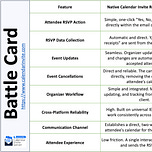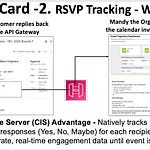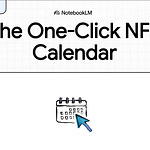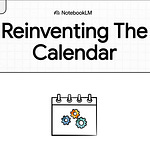Calendar Invite Server: A Comprehensive Briefing
Executive Summary
The Calendar Invite Server (CIS) is an API-driven messaging pipeline designed to replace the fragmented and inefficient “Add to Calendar” button and external RSVP form paradigm. Its core function is to enable the sending, tracking, updating, and canceling of native calendar invites directly from web pages, email templates, and applications. The system establishes a persistent, two-way communication channel between an event organizer and an attendee by leveraging the attendee’s own calendar client as the interface.
The key innovation lies in its workflow: an organizer uses their standard calendar client (e.g., Google Calendar, Outlook) to create, update, or cancel an event. These actions are sent to the CIS, which processes the data and makes it available via a REST API. When an attendee requests an invite, the API sends a standards-compliant iCalendar (ICS) invitation that works seamlessly across all major platforms. Critically, the system automates the collection of attendee responses (Yes, No, Maybe), referred to as “calendar receipts,” providing a direct feedback loop and a source of first-party engagement data.
Built entirely on a serverless AWS architecture, the CIS is packaged as a CloudFormation template for deployment into a customer’s own AWS account, ensuring data ownership and security. This approach transforms the calendar from a static scheduling tool into a dynamic marketing and communication channel, ideal for digital marketing agencies, software OEMs, and enterprises seeking to enhance event-based engagement.
1. Core Concept and Value Proposition
The primary goal of the Calendar Invite Server is to offer a superior alternative to the standard “Add to Calendar” button and separate RSVP form combination. This traditional method is prone to user error, creates a disconnected user experience, and provides no mechanism for event updates or reliable data collection.
The CIS resolves these issues by creating a messaging pipeline that mimics the functionality of a large-scale calendar server, such as Google’s or Microsoft’s, but is controlled via a REST API. The central value propositions are:
• Direct Communication Channel: Establishes a direct, two-way channel to the attendee’s calendar for the entire lifecycle of an event, allowing for seamless updates and promotional messaging.
• Automated RSVP Tracking: Automatically collects “calendar receipts” (Yes, No, Maybe responses) directly from the attendee’s calendar client, providing real-time engagement data without requiring the user to fill out a separate form.
• Unified Organizer Workflow: Allows organizers to manage the entire event lifecycle—creation, updates, and cancellations—from within their familiar native calendar client.
• Enhanced Attendee Experience: Provides a low-friction, single-click interaction within the email or web page that adds the event to the user’s calendar and simultaneously captures their RSVP status.
2. System Architecture and Workflow
The Calendar Invite Server is built on a serverless AWS stack, utilizing services such as SES, Lambda, S3, DynamoDB, and API Gateway. Its operation is divided into three core processors that handle the event lifecycle.
2.1. Inbound Processor
The workflow begins when an event organizer creates an event in their native calendar client (e.g., Google Calendar, Outlook) and sends the invitation to a designated AWS Simple Email Service (SES) email address.
1. Ingestion: The SES email box receives the calendar invite.
2. Disassembly: The invite data is disassembled, and the event is stored as a “NEW” entry in a DynamoDB database.
3. UID Assignment: A unique identifier (UID) is assigned to the event and associated with the organizer’s email address, linking them within the CIS pipeline.
This process allows the organizer to edit event details (date, time, location, message body) in their calendar client and have those changes automatically captured and stored by the server an unlimited number of times before the event expires.
2.2. Outbound Processor
The Outbound Processor sends calendar invites to attendees via a REST API endpoint.
1. API Call: The Calendar Invite Send Rest API Endpoint is called, typically triggered by an RSVP button in an email, a form on a web page, or an action within an application.
2. Data Assembly: The API matches the organizer’s email to the event UID, retrieves the corresponding data from DynamoDB, and uses ETL functions to reassemble a standards-compliant calendar invite.
3. Sending: The package is sent using AWS SES RAW, which ensures proper formatting for international language support and cross-platform compatibility.
4. Receipt Request: Each invite requests a “calendar receipt,” prompting the attendee’s client to send back their Y/N/M response.
2.3. Update/Cancel Processor
This processor automates the distribution of changes or cancellations to attendees who have already received an invite.
1. Organizer Action: The organizer edits or cancels the event in their native calendar client. This action sends the updated data to the Inbound Processor.
2. Automated Distribution: The system identifies all attendees who previously responded with “Yes” or “Maybe” to the initial invite for that event UID.
3. Resending: An updated or canceled calendar invite is automatically sent to these engaged attendees.
4. Data Recapture: For updates, calendar receipts are requested again to capture the new RSVP status. Canceled events are tagged as such in the database, and no further actions can be taken.
An optional workflow switch can be enabled in the Lambda function to require manual approval before updates or cancellations are sent out.
2.4. Data Collection and Analytics
The collection of RSVP data is a foundational feature of the CIS.
• Receipt Gathering: Calendar receipts (Y, N, M responses) are sent from the attendee’s client back to the API Gateway.
• Storage & Processing: The data is first stored in S3 and then processed into DynamoDB for analytics and decision-making.
• Real-Time Updates: Any change a user makes to their RSVP status in their calendar client is sent back and updated in the database, providing a live “intent signal.”
• Technical Parameters: Specific iCal parameters, such as ATTENDEE; PARTSTAT=NEEDS-ACTION and ORGANIZER, are configured to ensure calendar clients behave correctly and reliably transmit RSVP data.
3. Competitive Advantage: Native Invites vs. “Add to Calendar” Buttons
The CIS platform is positioned as a superior solution to the combination of “Add to Calendar” buttons and separate RSVP forms. The key differentiators are summarized below.
4. Primary Use Cases and Applications
The Calendar Invite Rest API is designed for four primary application scenarios.
4.1. Web Pages
The API can be used to send calendar invites directly from web pages. This includes auto-generating landing pages with event data injected, allowing customers to enter their email addresses for a “1-Click Calendar Invite.”
4.2. Email Marketing Templates
API event codes can be generated in the CIS console and embedded into the Call-To-Action (CTA) buttons of over 50 email marketing platforms (e.g., Mailchimp, Klaviyo). When a recipient clicks the button, the calendar invite is sent, its status is tracked, and the user can be redirected to a custom landing page.
4.3. In-App Integration
The REST API can be integrated into application workflows for transactional purposes. Examples include:
• Sending calendar invites for invoice due dates.
• Distributing mass reminders for events that users have already registered for.
• Sending machine-to-human maintenance notifications.
4.4. Custom Event Sites (The NFL Demo Deep Dive)
This use case is demonstrated through an NFL mini-site that virtualizes all 272 games of a season into dynamic, updatable calendar invites.
• Core Functionality: The site transforms static schedule data into live, standards-compliant ICS invites. When a fan requests an invite, it is delivered to their inbox. Any changes, such as flex scheduling, are automatically pushed to the fan’s calendar, which remains the single source of truth.
• First-Party Data Collection: Each sent invite creates a first-party record tied to the recipient. The system tracks real-time RSVP status (No Action, RSVP Yes, RSVP No, RSVP Maybe), turning the calendar into a “live intent signal.”
• Data Enrichment: Raw game data is enhanced with context like week groupings, team information (logos, links), and post-game stats and scores pulled from a public API (e.g., ESPN).
• Technical Architecture:
◦ Backend: The AWS-based Calendar Invite Server (CIS).
◦ Frontend: A Vue 3 Single-Page Application (SPA) styled with Tailwind CSS.
◦ Data Strategy: All data APIs are GET requests, ensuring the organizer’s calendar remains the system of record. Time is stored as UTC and displayed in the user’s local time zone on the frontend. Each game has a durable UID and a predictable deep link for sharing and indexing.
5. Productization and Market Strategy
5.1. Ideal Customer Profiles
The CIS targets four primary customer segments:
1. Large Digital Marketing Agencies: For managing web properties and email campaigns that can leverage calendar invites for promotions and event schedules.
2. Software OEMs: Companies like HubSpot, Mailchimp, or SAP that can integrate the API for both marketing and transactional sending.
3. Single OEM IP Buyer: An entity interested in acquiring the technology stack to take to market across various verticals.
4. AWS Partner: A partner to package the product for the AWS Marketplace and sell it as a per-server license to large AWS customers.
5.2. Packaging and Deployment
The product is delivered in two main packages:
• Back End: The Calendar Invite Server, including the Inbound, Outbound, and Update/Cancel processors, is packaged in an AWS CloudFormation template with documentation in GitHub.
• Front End: A console for organizers and domain owners, built in Vue.js, with an installer for AWS or CDN deployment.
The back-end template provisions all necessary AWS resources, including SES, SNS, SQS, API Gateway, Lambda, DynamoDB, S3, and Route 53.
5.3. Target Market Opportunity
The potential market is substantial:
• Domain Hosting Entities: Hundreds of millions of domain owners could run the server tied to their domain, leveraging their existing AWS SES service.
• AWS Ecosystem: A target opportunity exceeding 25 million users of AWS SES, including millions of SaaS and AI companies built on the AWS stack.
5.4. Security Model
The system follows a “you own it and you run it” deployment model. It runs entirely within the customer’s AWS account, adhering to AWS Serverless Security Best Practices.











